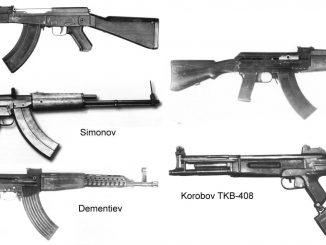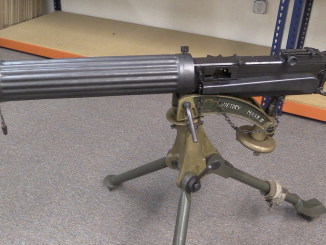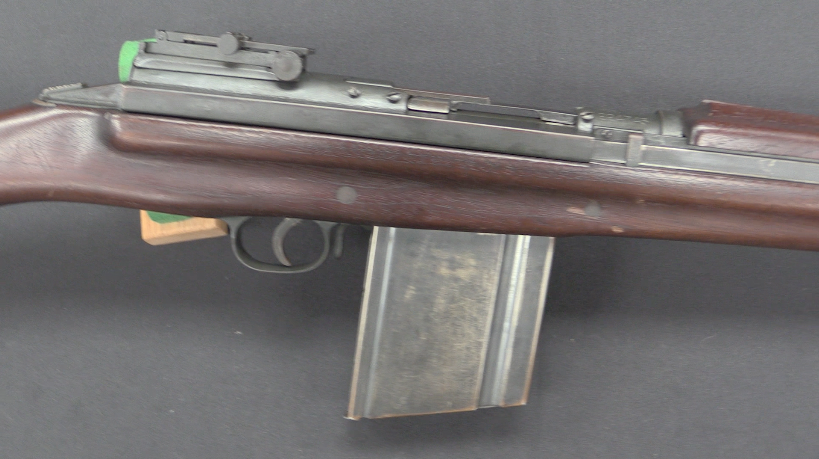The PP-19-01 Vityaz is a development of the PP-19 Bizon, a submachine gun developed by Izhmash at the request of the Russian Interior Ministry in the early 1990s. The Bizon design team included the sons of both Mikhail Kalashnikov and Evgeniy Dragunov, and they created a well-designed unlocked blowback adaptation of the AK system using a 64-round helical drum magazine and chambered for the 9x18mm Makarov cartridge. In actual use, the magazine proved unreliable (shocking…) and in the early 2000s a new version was developed based on the experience with many iterations of the Bizon.
This new version was the Vityaz, chambered for 9x19mm Parabellum and using a conventional 30-round double stack, double feed polymer magazine. It was made as a select fire submachine gun, but also offer in semiauto form on the civilian market as the Saiga-9. Kalashnikov USA is manufacturing a virtually indistinguishable copy here as the KP-9 pistol (or KP-9 rifle, with a 16 inch barrel). The example in this video is a KP-9 that has been registered as a short-barreled rifle and fitted with the appropriate side-folding stock to duplicate the form of a Vityaz.
Thanks to Kalashnikov USA for providing the KP-9 for this video!




“(…)Perfect Copy of the Russian Vityaz SMG(…)”
Could magazines be clipped together, as in PP-19-01, see 3rd image from top: https://modernfirearms.net/en/submachine-guns/russia-submachine-guns/pp-19-01-vitjaz-eng/
?
I wonder if helical magazines would work better if the cartridges were coated with something, lacquer or teflon, like the 5.7×28 uses? Also I wonder if they would work better with a slower rate of fire, less than 600rpm? The calico, Bizon and the Chinese smgs all fire above this. Maybe if they gave more time for the round to advance it would work better?
Helical magazines have been tried repeatedly, going back to pre-selfloading times. Look up the Evans repeating rifle, a lever-action with either a 24 or 32-round helical magazine in the stock.
Rate of fire or the slickness of the cartridge isn’t the problem. (And lubricated cartridges are a huge PITA in any weapon, and in a recoil-operated or blowback type can actually be dangerous to the operator.)
The problem is that you basically need a cartridge that is specifically shaped externally to function through such a feed system. Tapered cases (like the 9 x 19mm) and rimmed cases (like the two .44 Evans rounds, short and long) are two examples of “worst possible shape to run through an Archimedes-screw feed system”.
The best shape, or rather the least-worst, would be a true body of rotation; i.e. a simple cylinder with flat ends. Next best or least-worst would be something like the Dardick “tround”, also with flat ends. You don’t want any taper on either one.
Of course, this leaves you with the small problem the Dardick had, of using a round that can be loaded back-to-front and still be fed, with unfortunate results when it reaches the chamber.
(You pull trigger, firing pin hits nose of bullet instead of primer, you get a “click” instead of a “bang”, and the person you’re having an active disagreement with shoots your ass while you’re trying to get the thing up and running again.)
Short of an entirely new type of cartridge (Combustible Plastic Cased Telescoped Ammunition, anyone? )with the correct profile and at least some way to decrease the likelihood of a round ending up in the chamber ass-backwards, I don’t see any more future for the Archimedes-screw magazine than I do for caseless ammunition.
Going back to Ian’s gedanken-experiment on Elbonian small arms circa 1946, if I were designing a totally-new rifle for them from the ground up and I wanted to make certain it was unusable, it would be a delayed-blowback bullpup in 8 x 59 Breda with a Calico-type magazine on top of the action like the arrangement in the FN P90. Yes, that sort of thing was being experimented with at the time, notably by Mr. Anton Rosciszewski at Long Branch Arsenal. Toronto, Canada. Mr. Rosciszewski gave up on the idea because it was at best unreliable even in 9 x 19mm, even with a relatively simple Sten-type magazine plus a P90-type “turntable” built into the action.
A Calico-magazine delayed-blowback bullpup in 8 x 59 Breda should just about hit the (im)perfecta of “WTF were they thinking?” when anybody actually tried to use it.
cheers
eon
“(…)circa 1946(…)”
Hmm… that would need time travel but if you wish to cause “(…)“WTF were they thinking?”(…)” then consider PP-90M1: https://modernfirearms.net/en/submachine-guns/russia-submachine-guns/pp-90m1-eng/
it has helical magazine, but more unusually if you wish to cock it you have too… push button directly above barrel muzzle (see 4th image from top).
Not a technical gun guy but wouldnt a Calico Mag, delayed blowback 8MM Breda be very heavy, defeating the purpose of an SMG? I’m guessing 20lb (roughly 10kg for all the euro types).
I was thinking of it more as the infantry rifle or a SAW along the lines of the BAR. The “best case” would be to sell it to them as the Ultimate Assault Rifle; More Power, More Range, And More Rounds Than Anybody Else’s.
If you think that sort of “logic” flies in the face of what an assault rifle is supposed to be, you haven’t seen some of the things U.S. Army Ordnance came up with in the 1945-51 time frame while supposedly trying to develop an “assault rifle”.
This was before Project SALVO and before Ordnance came out publicly against that Continental Army Command (CONARC)/Infantry School proposal. SALVO was pretty much the birth of the the modern day High Velocity Small Caliber (HVSC) rifle, starting with the .224 Remington cartridge that evolved into the .223 aka 5.56 x 45mm.
NB; Actually, the .224 Rem. was about halfway “up” the SALVO design tree. They started with the .220 Swift. And considered multiple-bullet cartridges in calibers as small as .177- based on the .220 Swift case and powder charge. I kid you not.
But before that, Ordnance was under orders to develop a rifle similar to the German MKb42/MP43/StG44 family, to replace the M1 Garand and various SMGS. (But oddly enough, not the M1/M2 carbine or assorted shotguns. Hm.)
What Ordnance did at first was…adapt an M1 to take a 20-round BAR magazine and put a selector switch on it. They called it the T20. It went through several iterations, T22, T27, T36, and T47 until the end result emerged- the M14.
Simultaneously, CONARC and Co. were going through the T25, T28, T31 (a bullpup designed by John Garand), and T33 (an M1 carbine “blown up” to M1 Garand size), to…get nowhere. Mostly because they were constrained to base it around Ordnance’s cartridge design, which was the T65 series-that became 7.62 x 51 NATO aka .308 Winchester.
Garand was of the opinion that an “assault rifle” chambering the T65E3 cartridge (the final 7.62 x 51mm NATO/.308 Winchester) really meant that nobody involved had a clue what an “assault rifle” actually was. The result was neither an assault rifle (too powerful a cartridge for controllable autofire), an infantry rifle (ditto), or an effective SAW (too light for the job, no quick-change barrel).
So yes, you probably could convince a bunch of politicians (or generals) that a rifle with a 50-round magazine, weighing 10 kilos loaded, with a delayed-blowback action guaranteeing both an uncontrollably-high RoF and “catastrophic self-disassembly”, and firing a round suitable for anchoring Tarzan’s friend Tantor would be the “Ultimate Assault (or Battle) Rifle”.
If the Ordnance “experts” didn’t know any better, why would you expect politicians and generals to have a clue?
cheers
eon
Anton Rosciszewski also developed a precursor of sorts to Holek’s quest for a 9-mm SMG where the magazine sits flush within the stock–or nearly so–necessitating the 9-mm cartridge pointing up having to do a sort of porpoise or dolphin-like leap from the magazine to an upper feed ramp as the bullet is driven toward the chamber by the reciprocating bolt…
Like so:
https://servicepub.files.wordpress.com/2014/09/smg041.jpg
Say what you will, I rather like the stock with the checkering and the aperture sight…
Nice find ! Thought nothing could surprise me…
This Holek Czechoslovak ZB-47 prototype did the same–and there are additional Czechoslovak prototypes a bit different, but with the same feed concept:
http://www.imfdb.org/wiki/ZB-47
Of course, now I’m trying to find copies of those films, if only to have moving pictures of one!
“(…)do a sort of porpoise or dolphin-like leap(…)”
See also SOSSO sub-machine gun:
https://raigap.livejournal.com/282961.html
That’s the one I was thinking of. Found on pp. 290-291 of Small Arms of the World, 10th Ed.
cheers
eon
Ah, OK. Sorry about that. Or, “my bad.” I thought you were referring to a design that had transluscent magazines like the FN-P90’s, where the cartridges fed along the top facing to the left, and then somersaulted 90 degrees to face forwards prior to being chambered… For that matter, a bit like the “krautfreßer space magik–krieg der stern” tekno wünderwaffe G-11 4.7×33-mm caseless? In that case, oops, In that caselessness?, the cartridge was driven straight down, with the bullet pointed downwards into a rotating chamber that would, a bit like a locomotive wheel, be turned 90 degrees before it was hit by a contraption that caused the cartridge to break up, the bullet to go into the, erm, uh, well, not a feed way or chamber exactly, but whatever the German scientists called it, and then the propellant detonated, sending the cartridge down range. The P90 threw me.
cheers,
Dave
RE: 5.7, I was initially highly skeptical of the P90 mag (with the “gymnastics” it imposes on the cartridge), but hundreds of overwhelmingly 5.0 reviews can’t be wrong.
Perhaps adapting that proven-superb magazine to more cartridges might offer a higher probability of success than hoping multiple workarounds improve a concept that has consistently failed? Besides its reliability, the P90 mag is very space-efficient; helicals waste a lot of space outside (roundness) and in (winder mechanism).
Sadly a p90 magazine would only work in shorter cartridges to be practical and you are still limited by a double stack of rounds. For example a .223 has a 2.26 OAL. Even if the walls of the magazine are only .1″, that makes the magazine almost 2.5″ wide. That is a lot of width for a rifle or lmg if placed on the top. If it was placed on the side of the weapon then that is a little different. As for length, reducing two rows of cartridges to a single row and then twisting them to align them to the bore takes up a lot of room. A p90 magazine is what, 10+ inches long? Wouldn’t that make a 5.56 magazine 13+ inches long (I just scaled them based off of the differing diameters) for 50 rounds? Actually that doesn’t sound too bad now that I have typed it out but I do not know if it would be reliable.
I think the p90 magazine works so well due to the purposefully designed round, it has perfectly straight walls with some type of lubricant (at least that is what I read, hence my first comment when I was talking about helical magazines). I think helical magazines could be made to work with proper cartridge design, and something to reduce friction on the inside of the unit, though it raises the question of why you would do so. As Ian has already said, if you want high capacity make it belt fed.
Dan,
You make a lot of interesting points. I’ll try to address each in turn.
A P90ish 5.56 mag would be the width of an AR mag (even less pouch space, because not curved). It would also not widen the rifle significantly (if at all) beyond the handguard: https://www.ar15.com/forums/ar-15/Forend_Widths__Chart_/12-222002/
Since 5.56 is essentially twice the length of 9mm with near-identical diameters, only 50 would fit into a mag the size of a Calico 100 rounder – which is 2″ longer and over twice the thickness of a P90 mag.
To me an ideal round would be .221 Fireball, which would fit lengthwise in a P90 size mag without the side ribs. It would offer about equal performance to 5.56 in a PDW barrel, since the excess powder just makes muzzle flash anyway.
About 40 rounds of either would fit into a P90-length mag.
10mm would be a superb PDW cartridge as well, in a >1.5″ wide mag.
There are really two parts to the P90 magazine in terms of feeding. The helix at the end could be made of self-lubricating polymer (if it isn’t already). The rest is just a straight tube, which feeds moderately tapered cartridges reliably in the Uzi, MP-5/10, Thompson, etc.
I’m not advocating for belt-fed levels of capacity, but – having carried M9s with three 15rdrs in Iraq and Afghanistan – having similar no-reload capacity (+/-5) would be great. To me the real advantage of the P90 mag is its ability to reliably feed an ambidextrous bottom-ejecting 1.5ft shoulder weapon without (in stark contrast to a helical) adding significant size to the platform in any dimension.
I never did quite understand why FN went to the trouble to concoct the 5.7 x 28 round, which is pretty much a reiteration of the 5.7 Johnson MMJ/Spitfire or the .221 Fireball.
For that matter, Colt’s SCAMP (Small Caliber Automatic Machine Pistol) in the early 1970s could have been chambered for .221 (shorter case than 5.7 MMJ)and would have hit less like a mid-level 9 x 19mm and more like a fairly strenuous .357 Magnum.
“Proprietary” rounds and bragging rights are all well and good, but there is such a thing as re-inventing the wheel, too.
cheers
eon
Eon,
EXACTLY! I’ve thought along similar lines many times as well; both Spitfire and Fireball offer significantly better ballistics than 5.7 at a very modest sacrifice in capacity. The 5.7 does offer blowback “simplicity”, but that means light-AR weight despite being half the length; and it’s FN, so the simplicity actually costs more too.
True, I did not have an AR handy when I said 2.5″ seemed really wide. Now that I have one in hand though, if you can fit 40 in a magazine the same length as a p90s magazine, imagine what you could fit in a magazine around 18″ (the length from the front of the magwell to the butt stock on mine). I wonder if 60+ is doable? I wonder how much it would weigh to make the magazine sit flush with the sides of the weapon like in a p90? Great now I am imagining a 5.56 p90. Also thank you for your service and interesting insight.
Dan,
My pleasure, and thanks for your insights as well! I thought after my previous post about how long a 5.56 mag could be and still feed reliably in parallel. I wonder if stripper-clip-like internal flanges could guide the rims and keep the columns smooth.
If you’re talking about widening the receiver to mag width, you could place a piston or gas tube on one side and striker or hammer rod on the other, enabling a crisp forward trigger in a bullpup.
Regarding an 18-incher, two things to keep in mind: one, unlike the Calico, the P90 mag feeds from forward to aft. Two, the human dimension: no part of an average human body is 18+” without a joint. You could carry a bunch in a backpack, but none in a ready-service location (belt or chest) if you ever wanted to sit or tie your shoes 😉
@Mike:
5,7 mm Spitfire and 5,7 x 28 mm are similar
http://old.municion.org/22Carbine/5_7Mmj.htm
http://old.municion.org/5_7x28/5_7x28.htm
but second allow usage of longer bullets (difference between overall length and case length is greater) which is not without meaning considering that second was from start designed for penetrating personal armour.
Daweo,
With similar OAL and a shorter case, the FN cartridge could theoretically allow a bullet with a longer ogive. In practice, it uses extremely light-for-caliber bullets to meet velocity goals with its limited powder capacity.
In practice, the MMJ uses 40-50 grain bullets (23-31 are standard for FN), yet (with a 9mm case) achieves similar velocities as the 8mm-OD FN.
Thanks for sharing
Bolt mass seems somewhat little for a simple blowback, closed bolt gun with a barrel lenght at least 20 centimeters… Tubular bolt guide at front should have a floating high density metal rod in it… lMHO…
Thats what bolt carrier from open bolt Ultimax 100 has, what is the benefit of such addition (beside increased mass) ?
lf that mass were two pieces of different weights located with very small distances from each other, they would instantly join and rebound as giving different value impacts against fore and back and this would be used to slow the initial free blowback speed of bolt.
A bolt cannot be made heavier. He already breaks the receiver.
And you can’t alleviate it either. Then he breaks himself.
https://youtu.be/oH_FbCm1H4Q
They tried to fix this by adding rivet on the top cover.
Maybe it’s better. But this does not solve the root of the problem.
https://youtu.be/5DOKOJFASHE
Pretty curiosity design, but someone likes it…
Really… Oh my old mind…
I think they are too small to put in this AK bolt, too have direct effect here.
Barrel pin is really clever idea, perfect example of dual purpose part, which not many guns have.
That AK being used for comparison almost stole the Vityaz’ show..what is going on with its colorful furniture? Is it used as a reference of different AK stock colours?
Great find. Thanks for sharing.